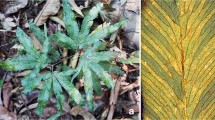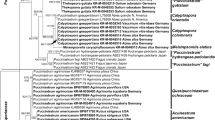Abstract
Rare pathogens on unusual hosts are often providing valuable insight into the evolution of the pathogen group concerned, but it is often challenging to obtain sequence data for these, as because only very few, often decades-old specimens are available. One such example is Albugo tropica, the white blister pathogen of a basal angiosperm in the genus Peperomia (Piperaceae). For this species, only two, more than 70 and over 120-year-old collections available. Here, sequence data for A. tropica are reported and phylogenetic reconstructions reveal it as the sister group to all other white blister rusts of the genus Albugo. Its isolated position is also reflected by several morphological differences to the other species of the genus, such as very thin-walled sporangia and almost smooth oospores. The isolated phylogenetic position of the pathogen and its host might indicate that it is a relict species trapped on its host. The sister-group relationship to all members of the genus Albugo s.str., which have been investigated using molecular phylogenetics, hints at the possibility, that Albugo might have originated in South America or Gondwana and has later radiated in the holarctic on members of the Brassicales.



Similar content being viewed by others
References
Altschul, S. F., Gish, W., Miller, W., Myers, E. W., & Lipman, D. J. (1990). Basic local alignment search tool. Journal of Molecular Biology, 215, 403–410.
Bachofer, M. (2004). Molekularbiologische Populationsstudien an Plasmopara halstedii, dem Falschen Mehltau der Sonnenblume, Dissertation, Stuttgart, Germany.
Biga, M. L. B. (1955). Riesaminazione delle specie del genere Albugo in base alla morfologia dei conidi. Sydowia, 9, 339–358.
Bock, C. H., Jeger, M. J., Fitt, B. D., & Sherington, J. (1997). Effect of wind on the dispersal of oospores of Peronosclerospora sorghi from sorghum. Plant Pathology, 46, 439–449.
Choi, D., & Priest, M. J. (1995). A key to the genus Albugo. Mycotaxon, 53, 261–272.
Choi, Y. J., & Thines, M. (2015). Host jumps and radiation, not co-divergence drives diversification of obligate pathogens. A case study in downy mildews and Asteraceae. PLoS One, 10(7), e0133655.
Choi, Y. J., Shin, H. D., & Thines, M. (2009). The host range of Albugo candida extends from Brassicaceae through Cleomaceae to Capparaceae. Mycological Progress, 8, 329–335.
Choi, Y. J., Thines, M., & Shin, H. D. (2011). A new perspective on the evolution of white blister rusts: Albugo s. str. (Albuginales; Oomycota) is not restricted to Brassicales but also present on Fabales. Organisms Diversity and Evolution, 11, 193–199.
Constantinescu, O. (1998). A revision of Basidiophora (Chromista, Peronosporales). Nova Hedwigia, 66, 251–265.
Constantinescu, O., & Thines, M. (2006). Dimorphism of sporangia in the Albuginaceae (Chromista, Peronosporomycetes). Sydowia, 58, 178–190.
Göker, M., Voglmayr, H., Riethmüller, A., Weiß, M., & Oberwinkler, F. (2003). Taxonomic aspects of Peronosporaceae inferred from Bayesian molecular phylogenetics. Canadian Journal of Botany, 81, 672–683.
Hudspeth, D. S. S., Nadler, S. A., & Hudspeth, M. E. S. (2000). A cox2 molecular phylogeny of the Peronosporomycetes. Mycologia, 92, 674–684.
Huelsenbeck, J. P., & Ronquist, F. (2001). MRBAYES: Bayesian inference of phylogenetic trees. Bioinformatics, 17, 754–755.
Kumar, S., Stecher, G., & Tamura, K. (2016). MEGA7: Molecular evolutionary genetics analysis version 7.0 for bigger datasets. Molecular Biology and Evolution, 33(7), 1870–1874.
Mirzaee, M. R., Ploch, S., Runge, F., Telle, S., Nigrelli, L., & Thines, M. (2013). A new presumably widespread species of Albugo parasitic to Strigosella spp. (Brassicaceae). Mycological Progress, 12, 45–52.
Mishra, B., Choi, Y.J., & Thines, M. (2017). Phylogenomics of Bartheletia paradoxa reveals its basal position in Agaricomycotina and that the early evolutionary history of basidiomycetes was rapid and probably not strictly bifurcating. Mycological Progress, (in press).
Mishra, B., & Thines, M. (2014). siMBa—a simple graphical user interface for the Bayesian phylogenetic inference program MrBayes. Mycological Progress, 13, 1255–1258.
Mishra, B., Ploch, S., Weiland, C., & Thines M. (unpublished). TrEase—a webserver to infer phylogenetic trees with ease. http://www.thines-lab.senckenberg.de/trease.
Moncalvo, J. M., Wang, H. H., & Hseu, R. S. (1995). Phylogenetic relationships in Ganoderma inferred from the internal transcribed spacers and 25S ribosomal DNA sequences. Mycologia, 87, 223–238.
Patouillard, N., & Lagerheim, G. (1892). Champignons de L’Équateur (Pugillus 2). Bulletin de la Société Mycologique de France, 8, 123.
Riess, K., Schön, M. E., Lutz, M., Butin, H., Oberwinkler, F., & Garnica, S. (2016). On the evolutionary history of Uleiella chilensis, a smut fungus parasite of Araucaria araucana in South America: Uleiellales ord. Nov. in Ustilaginomycetes. PLoS One, 11(1), e0147107.
Riethmüller, A., Voglmayr, H., Göker, M., Weiß, M., & Oberwinkler, F. (2002). Phylogenetic relationships of the downy mildews (Peronosporales) and related groups based on nuclear large subunit ribosomal DNA sequences. Mycologia, 94, 834–849.
Runge, F., Choi, Y. J., & Thines, M. (2011). Phylogenetic investigations in the genus Pseudoperonospora reveal overlooked species and cryptic diversity in the P. cubensis species cluster. European Journal of Plant Pathology, 129, 135–146.
Scheuer, C., Bauer, R., Lutz, M., Stabentheiner, E., Mel'nik, V. A., & Grube, M. (2008). Bartheletia paradoxa is a living fossil on Ginkgo leaf litter with a unique septal structure in the Basidiomycota. Mycological Research, 112, 1265–1279.
Tamura, K., & Nei, M. (1993). Estimation of the number of nucleotide substitutions in the control region of mitochondrial DNA in humans and chimpanzees. Molecular Biology and Evolution, 10, 512–526.
Telle, S., & Thines, M. (2008). Amplification of cox2 (~620 bp) from 2 mg of up to 129 years old herbarium specimens, comparing 19 extraction methods and 15 polymerases. PLoS One, 3, e3584.
Telle, S., & Thines, M. (2012). Reclassification of an enigmatic downy mildew species on lovegrass (Eragrostis) to the new genus Eraphthora with a key to the genera of the Peronosporaceae. Mycological Progress, 11, 121–129.
Thiers, B. (2017). Index Herbariorum: A global directory of public herbaria and associated staff. New York Botanical Garden's Virtual Herbarium. http://sweetgum.nybg.org/ih.
Thines, M. (2006). Evaluation of characters available from herbarium vouchers for the phylogeny of the downy mildew genera (Chromista, Peronosporales), with focus on scanning electron microscopy. Mycotaxon, 97, 195–218.
Thines, M. (2009). Bridging the Gulf: Phytophthora and downy mildews are connected by rare grass parasites. PLoS One, 4, e4790.
Thines, M. (2010). Evolutionary history and diversity of white blister rusts. Polish Botanical Journal, 55, 259–264.
Thines, M. (2014). Phylogeny and evolution of plant pathogenic oomycetes-a global overview. European Journal of Plant Pathology, 138, 431–447.
Thines, M., & Spring, O. (2005). A revision of Albugo (Chromista, Peronosporomycetes). Mycotaxon, 92, 443–458.
Thines, M., & Voglmayr, H. (2009). An introduction to the white blister rusts (Albuginaceae). In K. Lamour & S. Kamoun (Eds.), Oomycete genetics and genomics: biology, interactions with plants and animals, and toolbox (pp. 77–92). Blackwell: Wiley.
Thines, M., Göker, M., Oberwinkler, F., & Spring, O. (2007). A revision of Plasmopara penniseti, with implications for the host range of the downy mildews with pyriform haustoria (DMPH). Mycological Research, 111, 1377–1385.
Thines, M., Göker, M., Telle, S., Ryley, M., Mathur, K., Narayana, Y. D., et al. (2008). Phylogenetic relationships of graminicolous downy mildews based on cox2 sequence data. Mycological Research, 112, 345–351.
Toome, M., Ohm, R. A., Riley, R. W., James, T. Y., Lazarus, K. L., Henrissat, B., et al. (2014). Genome sequencing provides insight into the reproductive biology, nutritional mode and ploidy of the fern pathogen Mixia osmundae. New Phytologist, 202, 554–564.
Voglmayr, H. (2003). Phylogenetic relationships of Peronospora and related genera based on nuclear ribosomal ITS sequences. Mycological Research, 107, 1132–1142.
Voglmayr, H., & Riethmüller, A. (2006). Phylogenetic relationships of Albugo species (white blister rusts) based on LSU rDNA sequence and oospore data. Mycological Research, 110, 75–85.
Voglmayr, H., Riethmüller, A., Göker, M., Weiß, M., & Oberwinkler, F. (2004). Phylogenetic relationships of Plasmopara, Bremia and other genera of downy mildews with pyriform haustoria based on Bayesian analysis of partial LSU rDNA sequence data. Mycological Research, 108, 1011–1024.
Walker, J., & Priest, M. J. (2007). A new species of Albugo on Pterostylis (Orchidaceae) from Australia: confirmation of the genus Albugo on a monocotyledonous host. Australasian Plant Pathology, 36, 181–185.
Wilson, G.W. (1907). Studies in North American Peronosporales – I. The genus Albugo. Bulletin of the Torrey Botanical Club, 34(2), 61–84.
Acknowledgements
We are thankful to the curators of the herbaria of the Muséum National d'Histoire Naturelle Cryptogames (PC), the Conservatoire et Jardin Botaniques de la Ville de Genève (G) and the United States National Fungus Collections (BPI) for providing specimens on loan. YJC was supported by a fellowship of the Alexander von Humboldt foundation.
Author information
Authors and Affiliations
Corresponding authors
Rights and permissions
About this article
Cite this article
Ploch, S., Choi, YJ. & Thines, M. The only known white blister rust on a basal angiosperm is a member of the genus Albugo . Org Divers Evol 18, 63–69 (2018). https://doi.org/10.1007/s13127-017-0353-3
Received:
Accepted:
Published:
Issue Date:
DOI: https://doi.org/10.1007/s13127-017-0353-3




